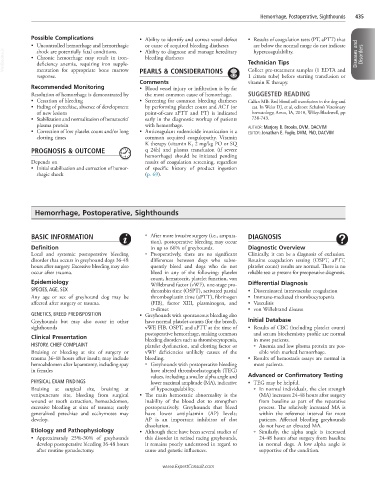Page 896 - Cote clinical veterinary advisor dogs and cats 4th
P. 896
Hemorrhage, Postoperative, Sighthounds 435
Possible Complications • Ability to identify and correct vessel defect • Results of coagulation tests (PT, aPTT) that
or cause of acquired bleeding diatheses
• Uncontrolled hemorrhage and hemorrhagic • Ability to diagnose and manage hereditary are below the normal range do not indicate
VetBooks.ir • Chronic hemorrhage may result in iron- bleeding diatheses Technician Tips Diseases and Disorders
hypercoagulability.
shock are potentially fatal conditions.
deficiency anemia, requiring iron supple-
mentation for appropriate bone marrow
response. PEARLS & CONSIDERATIONS Collect pre-treatment samples (1 EDTA and
1 citrate tube) before starting transfusion or
Comments vitamin K therapy.
Recommended Monitoring • Blood vessel injury or infiltration is by far
Resolution of hemorrhage is demonstrated by the most common cause of hemorrhage. SUGGESTED READING
• Cessation of bleeding • Screening for common bleeding diatheses Callan MB: Red blood cell transfusion in the dog and
• Fading of petechiae, absence of development by performing platelet count and ACT (or cat. In Weiss DJ, et al, editors: Schalm’s Veterinary
of new lesions point-of-care aPTT and PT) is indicated hematology, Ames, IA, 2010, Wiley-Blackwell, pp
• Stabilization and normalization of hematocrit/ early in the diagnostic workup of patients 738-743.
plasma protein with hemorrhage. AUTHOR: Marjory B. Brooks, DVM, DACVIM
• Correction of low platelet count and/or long • Anticoagulant rodenticide intoxication is a EDITOR: Jonathan E. Fogle, DVM, PhD, DACVIM
clotting times common acquired coagulopathy. Vitamin
K therapy (vitamin K 1 2 mg/kg PO or SQ
PROGNOSIS & OUTCOME q 24h) and plasma transfusion (if severe
hemorrhage) should be initiated pending
Depends on results of coagulation screening, regardless
• Initial stabilization and correction of hemor- of specific history of product ingestion
rhagic shock (p. 69).
Hemorrhage, Postoperative, Sighthounds
BASIC INFORMATION ○ After more invasive surgery (i.e., amputa- DIAGNOSIS
tion), postoperative bleeding may occur
Definition in up to 66% of greyhounds. Diagnostic Overview
Local and systemic postoperative bleeding ○ Preoperatively, there are no significant Clinically, it can be a diagnosis of exclusion.
disorder that occurs in greyhound dogs 36-48 differences between dogs who subse- Routine coagulation testing (OSPT, aPTT,
hours after surgery. Excessive bleeding may also quently bleed and dogs who do not platelet count) results are normal. There is no
occur after trauma. bleed in any of the following: platelet reliable test at present for preoperative diagnosis.
count, hematocrit, platelet function, von
Epidemiology Willebrand factor (vWF), one-stage pro- Differential Diagnosis
SPECIES, AGE, SEX thrombin time (OSPT), activated partial • Disseminated intravascular coagulation
Any age or sex of greyhound dog may be thromboplastin time (aPTT), fibrinogen • Immune-mediated thrombocytopenia
affected after surgery or trauma. (FIB), factor XIII, plasminogen, and • Vasculitis
D-dimer. • von Willebrand disease
GENETICS, BREED PREDISPOSITION • Greyhounds with spontaneous bleeding also
Greyhounds but may also occur in other have normal platelet counts (for the breed), Initial Database
sighthounds vWF, FIB, OSPT, and aPTT at the time of • Results of CBC (including platelet count)
postoperative hemorrhage, making common and serum biochemistry profile are normal
Clinical Presentation bleeding disorders such as thrombocytopenia, in most patients.
HISTORY, CHIEF COMPLAINT platelet dysfunction, and clotting factor or ○ Anemia and low plasma protein are pos-
Bruising or bleeding at site of surgery or vWF deficiencies unlikely causes of the sible with marked hemorrhage.
trauma 36-48 hours after insult; may include bleeding. • Results of hemostasis assays are normal in
hemoabdomen after laparotomy, including spay ○ Greyhounds with postoperative bleeding most patients.
in females have altered thromboelastograph (TEG)
values, including a smaller alpha angle and Advanced or Confirmatory Testing
PHYSICAL EXAM FINDINGS lower maximal amplitude (MA), indicative • TEG may be helpful.
Bruising at surgical site, bruising at of hypocoagulability. ○ In normal individuals, the clot strength
venipuncture site, bleeding from surgical • The main hemostatic abnormality is the (MA) increases 24-48 hours after surgery
wound or tooth extraction, hemoabdomen, inability of the blood clot to strengthen from baseline as part of the reparative
excessive bleeding at sites of trauma; rarely postoperatively. Greyhounds that bleed process. The relatively increased MA is
generalized petechiae and ecchymoses may have lower antiplasmin (AP) levels; within the reference interval for most
develop. AP is an important inhibitor of clot patients. Affected bleeding greyhounds
dissolution. do not have an elevated MA.
Etiology and Pathophysiology • Although there have been several studies of ○ Similarly, the alpha angle is increased
• Approximately 25%-30% of greyhounds this disorder in retired racing greyhounds, 24-48 hours after surgery from baseline
develop postoperative bleeding 36-48 hours it remains poorly understood in regard to in normal dogs. A low alpha angle is
after routine gonadectomy. cause and genetic influences. supportive of the condition.
www.ExpertConsult.com

